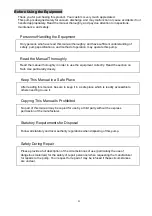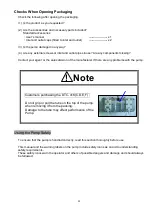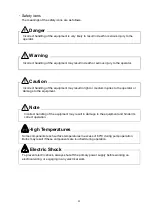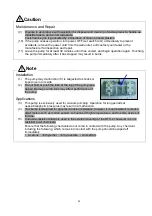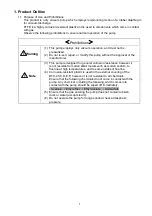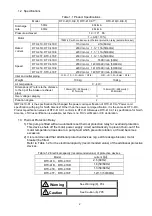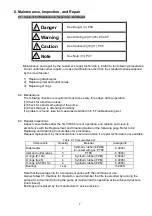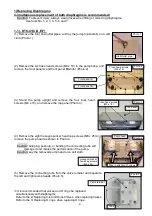
5
Fig.3.1 Example of Piping When discharging a Vessel
3.6 Storage
Turn the switch OFF (set to O), remove the power plug from the outlet, place the rubber caps
over the inlet and outlet, and store the pump in an area of low humidity.
4. Cautions for Operation
4.1 Cautions for Operation
See Danger (1)(2), P04
See Warning (8)(14)(15)(16), P04,05
See Caution (4)(5)(6)(7)(8), P05
See Note (3)(4)(5)(6)(7)(8)(9)(10)(11)(12),
P06,07
1) To maintain the performance of the pump, always ensure that it is cleaned internally after use.
Clean by ingesting clean air for 3~5 minutes under no-load conditions.
2) Consult the manufacturer if the pump is to be used in a special application.
4.2 Operation of the Thermal Protection Relay
1) When the thermal protection relay operates, switch the pump power supply OFF (set to O),
remove the power cord from the outlet, and contact the manufacturer. Note that the pump will
be very hot and should not be touched.
2) The pump operates automatically when temperature drops. Shut-off the power supply, and
determine the cause of operation of the thermal protection relay.
3) Once the cause of the fault has been removed, wait until the motor cools and restart
operation.
See Caution (6), P05
4.3 Starting in Cold Weather
Cold weather will increase the viscosity of bearing grease and harden diaphragms, resulting in
the pump being difficult to start. Follow the procedure below in such conditions.
1) Turn the switch ON/OFF 2~3 times with the inlet open to atmosphere until the pump starts. If
the pump still does not start, raise the ambient temperature to beyond 0°C.
2) With the inlet open to atmosphere, run the pump for a few minutes to warm it.
3) Commence normal operation once the pump has warmed.
Vacuum pump
Filter
Leak valve
Shut-off valve Vessel
!
Warning
!
Caution
!
Note
!
Caution
!
Danger




